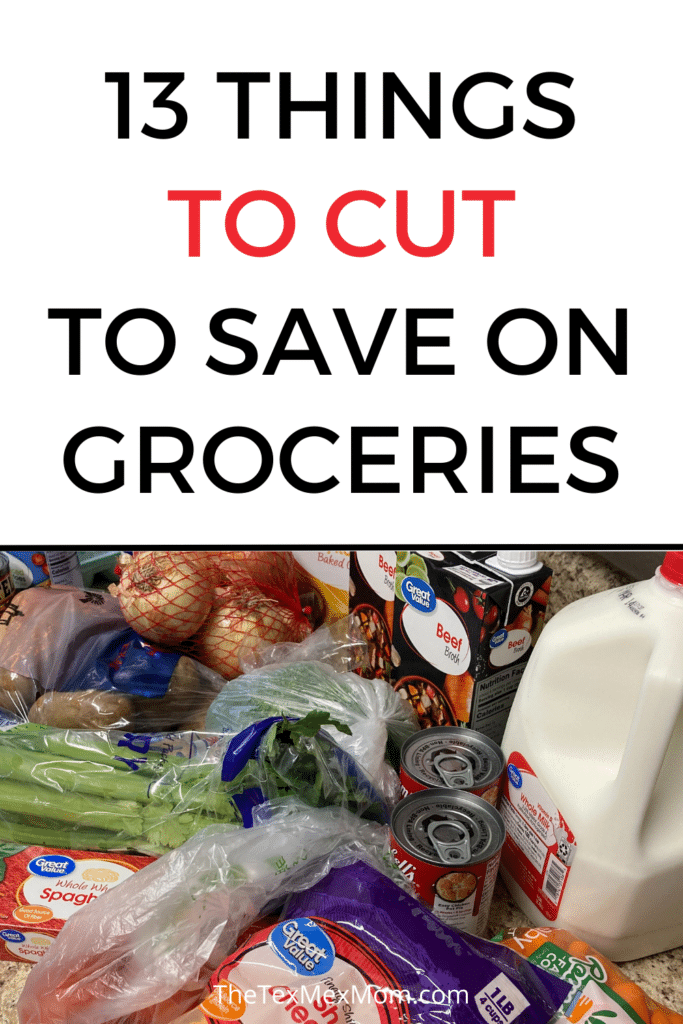Grocery prices are rising with inflation. How can you spend less on groceries? Here are 13 things to stop buying to save on your grocery bill.
I know it’s not news to any of you that food prices are rising. It’s affecting all of us and frankly it stinks.
Recently I compared prices from this popular meal plan I shared 2 years ago and – get this – the cost for the same groceries was a whopping 32% higher. Yikes!
Even more alarmingly, a few weeks ago I took a $50 grocery list from 2019 and bought all the same items again to compare prices. Any guess how much I spent? (It was a more than 50% increase!) I shared my whole grocery haul and all the price comparisons in this video here.
I know that it can be discouraging to go grocery shopping and spend so much money for what feels like very few groceries. It feels like any raise you might earn at work will be immediately negated by inflation. Add in a growing family with growing appetites and it can feel increasingly difficult to make ends meet.
But there are things we can do to pinch pennies and still save money here and there. Obviously groceries aren’t the only area inflation has hit, but it’s one area where we can make little changes that can end up significantly cutting our grocery bills.
Do a quick search online for saving money on groceries in 2024 and you’ll see that people are searching for things like:
- How can I save 50% on groceries?
- How can I spend less than $100 a week on groceries?
- How can I cut my grocery bill by 90%? (oof, I’m not sure if this one’s possible!)
Clearly, many people are searching for ways to reduce their groceries bills!
I’ve shared lots of general money-saving tips here in the past. We’ve discussed how to come up with a monthly grocery budget and we’ve talked about all sorts of ways to save on groceries. Today though I thought we could tackle this topic from a slightly different angle by discussing some specific things on your grocery list that you should STOP buying to save money.
So let’s jump right in and talk through thirteen things you should stop buying when you want to save money on groceries.

10 Things to Cut to Save on Your Grocery Bill
1. Drinks
When I’m on a tight grocery budget, drinks are the first thing to go. Pablo loves LaCroix and other similar drinks and I’ve really started enjoying Vitamin Water. And of course we’re good Texans and love us some Dr. Pepper. But when we’re really trying to spend less on groceries drinks are one of the first things to get cut from our grocery list. Even bottled water, while obviously cheaper, is still pricier than just using a regular reusable water bottle and filling it with tap water.
And while I personally choose not to drink alcohol, I don’t want to forget to mention it here since that’s obviously a big one that can cost you a lot of extra money on your grocery bill too.
2. Prepped produce
I love the convenience of bagged salads and the pre-cut fruits and veggies in the produce section always look tempting. But make a quick price comparison and you’ll see that they are just not a great deal, being much more expensive than just getting your own produce to prepare yourself. (Just do it right away so it doesn’t die a slow death in your fridge’s produce drawer!)
One caveat that I will make is that prepped produce and other convenience type foods are often still cheaper than fast food or eating out, so if you’re working on eating out less, grocery store convenience foods can sometimes be helpful for a bit. (Small changes, little by little, right?)
3. Pre-portioned foods
It’s the time of year when lots of people are buying snacks like crackers, chips, etc. to go with their kids’ school lunches. While it’s super convenient to buy individually packaged items, it’s typically a better deal to buy a regular bag of chips or box of crackers and portion them out yourself.
4. Multiple snack options
Some of us are really great about meal planning and being intentional when it comes to grocery shopping for those planned meals, but then we blow the budget on snacks. Well, contrary to what your kids may tell you, you don’t need ten snack options in your pantry at all times! Buying lots of snacks is a sure way to run up your grocery bill. Maybe try to have just a couple snack options one week and then switch things up the following week. Things like fresh fruit that’s in season, homemade snacks, and pretzels are less expensive and still satisfy the need for a snack.
5. Regularly priced meat
I almost never buy regularly priced beef or ground beef. I’m sorry but $8 per pound for a basic chuck roast is not okay haha. Thankfully our local Kroger has sales regularly so I always watch for those sale items and try to stock up a bit if I can when there are especially good deals.
I’ve even started waiting for sales on chicken as well since those prices have also risen considerably. Our Kroger had chicken breasts for only $1.77 a pound a couple weeks ago – that’s almost half what they cost regularly at Walmart now.
6. Name brands
This one might be a no-brainer but I still wanted to mention it. One of the easiest ways to save on groceries is to simply avoid the brand-name products and purchase store-brand products which are almost always the more cost-effective alternative. For many products you probably wouldn’t even be able to tell the difference between the name brands and the store brands in a blind taste test.
Of course there are a few products where the name brand is clearly better (I’m looking at you Cheez-Its and Oreos) but if you can make yourself branch out and buy the generic products you’ll definitely save money!
7. Fancy ingredients
One thing that can really run up your grocery bill is when you decide to try out new recipes that call for a bunch of fancy ingredients that you don’t have on hand. Now, I’m not saying never branch out and try new things, but when you’re on a tight budget it’s a smart idea to stick to simpler meals that call for basic ingredients that you typically use.
Another idea for when your recipe calls for an ingredient that you don’t have and probably won’t use again would be to see if there’s a good (and cheaper) substitute that you could use instead.
8. Out of season fruit
My family and I love fruit so I especially love the summer months when all the fruit is on sale and I can buy berries, peaches, grapes, and more for great prices. At other times of the year though we rarely buy some of those fruits because they’re not in season and are priced much higher.
During those times of year I tend to stick to our staple fruits – apples and bananas – and often oranges in the cooler months. And of course I always keep my eye out for sales on the other fruits no matter the time of year.
9. Cereal
This may seem like an odd food item to mention – cereal isn’t THAT expensive – but let me tell you, with multiple kids you can go through it so fast! Even the basic store-brand cereal has gone up in price lately, so if you’re on a tight budget you may want to consider other breakfast options.
Eggs are much more filling and are currently back down to a good price thankfully. Oats are another great option. A 42 oz. container of oats doesn’t cost much more than a box of cereal and will stretch farther and fill tummies for longer too.
10. Foods you won’t use
Back in 2020 everyone ran out and bought all the shelf staples from the grocery stores, including lots of beans and rice. It was probably the only time that I haven’t been able to find those really basic food items at the store. Basics like beans and rice are cheap and are a great food to buy when you’re broke, but I can guarantee you that there are a lot of people who stocked up on beans, rice, canned veggies, tuna, etc. and then never ate them.
Some of you may have memberships at wholesale clubs like Sam’s or Costco where you can buy bulk, and that’s a good idea if you and your family members will eat everything you buy and it saves you money. But again, don’t buy what you won’t actually end up using.
The bottom line is that no matter how cheap it is it’s still a waste of money if you’re not actually going to eat it. 🙂
11. Paper products
While not food, paper products such as paper towels, paper napkins, and disposable plates are all easy items to cut from your grocery list which is a great way to save a lot of money (and it’s better for the environment too!)
12. Fancy coffee
Again, not a grocery item per se, but how many of us have been really careful about what we buy at the grocery store and then stopped for a five or six dollar coffee on the way home. You will save a lot of money if you just make your own coffee. (Get a French press or a quality coffee maker and little basic frother you can still have “fancy” coffee for a fraction of the cost!)
13. Impulse purchases
One simple way to fight against impulse purchases is simply to make a shopping list! But if you struggle with making unnecessary purchases in the grocery store try switching to ordering your groceries online and doing grocery pickup for no extra cost.
So, that’s my list of 13 things to cut to save on your grocery bill. As you can see, none of these are mind blowing ideas, but it’s little simple changes like I’ve mentioned that can end up saving you lots of money in the long run.
Do you agree or disagree? What are you going to cut from your shopping list and stop buying the next time you go to the grocery store? Let me know in the comments!


That’s 10 great tips for saving at the grocery store. I used all of them when we raised our kids on one income and it wasn’t a high paying job that income came from. I also cooked a lot from scratch.
Yes, cooking from scratch helps so much! Thanks for your comment!
I am a reader from Norway, and let me tell you, we could only dream of the prices on food you guys have! My husband is American, and we have visited family a lot in the states over the years, and are always amazed at the prices you get on groceries.
Yesterday i was pleased to find chicken breasts on sale here for 7 dollars per pound!
Oof that is high! A good reminder to me to be thankful when I’m tempted to complain. Also Norway wow how cool, I’d love to visit that country someday!